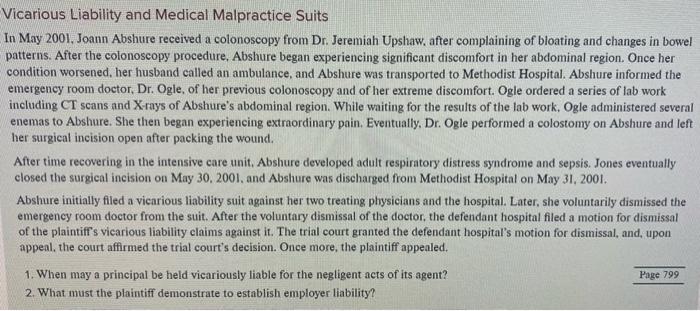Vicarious Liability and Medical Malpractice Suits In May 2001, Joann Abshure received a colonoscopy from Dr. Jeremiah Upshaw, after complaining of bloating and changes in bowel patterns. After the colonoscopy procedure. Abshure began experiencing significant discomfort in her abdominal region. Once her condition worsened, her husband called an ambulance, and Abshure was transported to Methodist Hospital. Abshure informed the emergency room doctor, Dr. Ogle, of her previous colonoscopy and of her extreme discomfort. Ogle ordered a series of lab work including CT scans and X-rays of Abshure's abdominal region. While waiting for the results of the lab work. Ogle administered several enemas to Abshure. She then began experiencing extraordinary pain. Eventually, Dr. Ogle performed a colostomy on Abshure and left her surgical incision open after packing the wound, After time recovering in the intensive care unit, Abshure developed adult respiratory distress syndrome and sepsis. Jones eventually closed the surgical incision on May 30, 2001, and Abshure was discharged from Methodist Hospital on May 31, 2001. Abshure initially filed a vicarious liability suit against her two treating physicians and the hospital. Later, she voluntarily dismissed the emergency room doctor from the suit. After the voluntary dismissal of the doctor, the defendant hospital filed a motion for dismissal of the plaintiff's vicarious liability claims against it. The trial court granted the defendant hospital's motion for dismissal, and, upon appeal, the court affirmed the trial court's decision. Once more, the plaintiff appealed. 1. When may a principal be held vicariously liable for the negligent acts of its agent? Page 799 2. What must the plaintiff demonstrate to establish employer liability? Vicarious Liability and Medical Malpractice Suits In May 2001, Joann Abshure received a colonoscopy from Dr. Jeremiah Upshaw, after complaining of bloating and changes in bowel patterns. After the colonoscopy procedure. Abshure began experiencing significant discomfort in her abdominal region. Once her condition worsened, her husband called an ambulance, and Abshure was transported to Methodist Hospital. Abshure informed the emergency room doctor, Dr. Ogle, of her previous colonoscopy and of her extreme discomfort. Ogle ordered a series of lab work including CT scans and X-rays of Abshure's abdominal region. While waiting for the results of the lab work. Ogle administered several enemas to Abshure. She then began experiencing extraordinary pain. Eventually, Dr. Ogle performed a colostomy on Abshure and left her surgical incision open after packing the wound, After time recovering in the intensive care unit, Abshure developed adult respiratory distress syndrome and sepsis. Jones eventually closed the surgical incision on May 30, 2001, and Abshure was discharged from Methodist Hospital on May 31, 2001. Abshure initially filed a vicarious liability suit against her two treating physicians and the hospital. Later, she voluntarily dismissed the emergency room doctor from the suit. After the voluntary dismissal of the doctor, the defendant hospital filed a motion for dismissal of the plaintiff's vicarious liability claims against it. The trial court granted the defendant hospital's motion for dismissal, and, upon appeal, the court affirmed the trial court's decision. Once more, the plaintiff appealed. 1. When may a principal be held vicariously liable for the negligent acts of its agent? Page 799 2. What must the plaintiff demonstrate to establish employer liability







